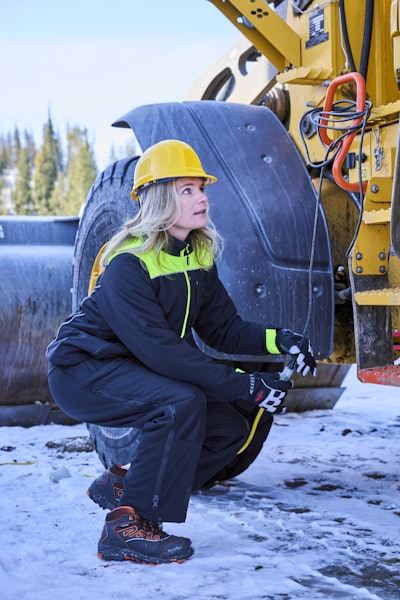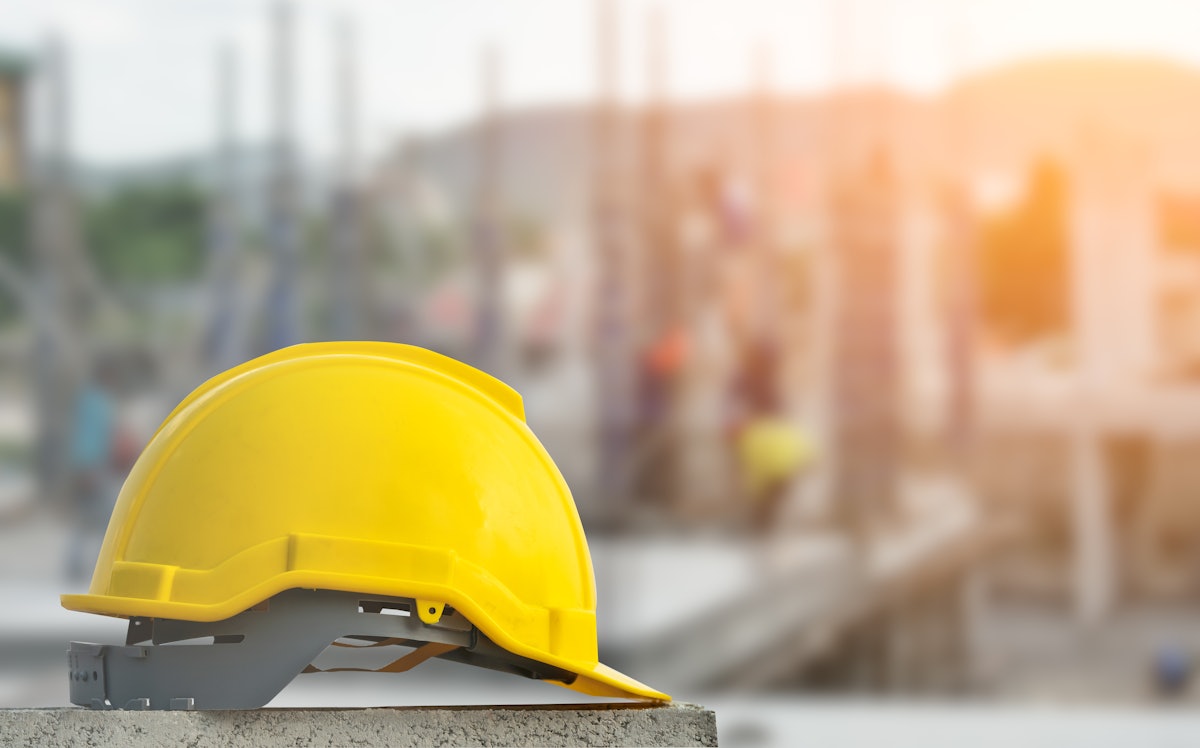Pouring concrete is dangerous work. Cement dust irritates the eyes, skin, and lungs. Holding a pump hose is hard on the hands. Tip-toeing across rebar is tough on the feet. Now, imagine trying to get that concrete poured while wearing floppy goggles, oversized gloves, an ill-fitting safety vest, and overly bulky work boots. That’s exactly what thousands of women in construction have been doing for decades.
It’s been a long time coming, but now concrete construction workers have the same PPE protections as their colleagues in shipyards and general industry, thanks to an updated OSHA rule.
OSHA finalized a revision to its personal protective equipment (PPE) standard for construction to explicitly state that PPE must fit properly. The final rule, Personal Protective Equipment in Construction, took effect in January 2025 and affirms OSHA’s position that properly fitting PPE is required as a critical element of an effective occupational safety and health program. The rule applies to all construction workers, including women, as well as workers specializing in concrete.
What Does the Rule Say?
OSHA estimates that approximately 14% of construction workers in the U.S. are women. However, most construction workwear and PPE for concrete workers are designed for men.
The final rule has two stipulations. First, PPE used by construction workers must be of a safe design and construction for the work being performed. Second, it must fit each affected employee properly.
PPE such as hard hats, high-visibility safety vests, safety toe boots, and cut- or chemical-resistant work gloves have long been part of the concrete construction worker’s uniform. Without question, these items are designed and built to deliver a certain level of protection for the work concrete professionals do. Such standard PPE is readily available from multiple manufacturers, distributor,s and retailers, so it’s easy for employers to procure safety gear for their employees.
The second part of the rule, which now specifies that such PPE must properly fit all affected employees — including women — has safety managers and concrete business owners taking another look at their PPE policies and procurement processes.
How Does the Rule Impact Women in Concrete Construction?
OSHA estimates that approximately 14 percent of construction workers in the U.S. are women. (Personal Protective Equipment in Construction, 89 Fed. Reg., 100333 (December 12, 2024)) However, most construction workwear and PPE for concrete workers are designed for men.
Female construction workers end up with ill-fitting safety vests that bag around the waist and shoulders, increasing the risk of injury from snagging on passing vehicles or moving parts of machinery. Work boots sized for men don’t adequately protect women’s feet and do virtually nothing to prevent foot fatigue by properly absorbing the impact of walking across rebar or uneven surfaces during a long shift. Oversized work gloves reduce dexterity, increase the risk of injury when excess fabric gets caught in machinery, and make it unnecessarily difficult for female concrete workers to handle materials or run the equipment.
OSHA’s final rule acknowledges these challenges and their impact on worker safety, particularly for female concrete construction workers. Under the revised regulations, employers must supply PPE that fits women properly and other workers with non-standard or extended-size requirements.
This shift in fit requirement is expected to drive demand for better-fitting safety gear, pressuring manufacturers to design construction workwear and PPE for a wider range of sizes and body types. Then, it will be easier for women working in concrete construction to find the safety gear they need to get their jobs done without the aggravation and safety risks that come with improperly sized and uncomfortable PPE.
What Does the Rule Mean for Employers?
While it takes about a year for a final rule to be incorporated into law, employers in the concrete construction business should start bringing their PPE policies and procurement practices into compliance now to avoid future OSHA citations.
Evaluate Current PPE Needs
The first step in achieving compliance with the updated rule is to evaluate which employees need PPE.
Concrete business owners should consider the kinds of work each employee performs and what hazards may be present on the job site. They should also know which safety standards must be met, such as those for high-visibility clothing, safety-toe work boots, chemical-resistant gloves, and protective eyewear.
Finally, employers must understand the range of sizes needed to outfit each employee properly. Employers should check with their crews to see which employees are currently using ill-fitting PPE that does not follow the updated rule. Gather size information from those employees or take arm, inseam, chest, and waist measurements to find the required size for a proper fit.
Explore Options for Fit & Function
In its final rule, OSHA explains that properly fitting PPE is “the appropriate size to provide an employee with the necessary protection from hazards and does not create additional safety and health hazards arising from being either too small or too large.”
OSHA also maintains that instructions and recommendations from manufacturers are important sources of information for selecting PPE that follows the updated rule. For example, PPE manufacturers who belong to the International Safety Equipment Association (ISEA) have been working with OSHA officials throughout the rulemaking process to understand the new rule’s fit requirements. They have also talked with customers and construction safety managers to better understand the range of body types and sizes required by construction crews.  Female construction workers are more productive when they have PPE that fits properly.RefrigiWear
Female construction workers are more productive when they have PPE that fits properly.RefrigiWear
Safety managers and concrete business owners can find compliant PPE in the ISEA Buyers Guide. The Guide includes links to ISEA-member manufacturers who design PPE sizes for women and non-standard sizes for both men and women in short and tall lengths and extended sizes from 3XL to 5XL.
However, it’s still incumbent upon the employer to pay close attention to the size specifications for PPE recommended by a supplier to ensure that the PPE is a proper match for the employee’s size requirements.
Look for labels or ask the supplier to explain whether the PPE was designed for men, for women, or a unisex fit. Then, use the instructions provided in the size chart to ensure that measurements are taken correctly for the best fit. For example, when sizing for high-visibility insulated outerwear, most manufacturers recommend taking measurements over the base layers that will be worn with the outerwear. Employees may be surprised to find that their size in this type of PPE differs from the size they would select for regular clothing.
Comfort Counts Toward Compliance
Safety gear that fits properly, functions correctly for the work being performed and is comfortable during long shifts can save lives and prevent serious injuries for concrete workers.
Employees who express discomfort in their PPE should be taken seriously, as such complaints could indicate that the PPE is not fit for its protective purpose and an improper fit could create an additional hazard. In fact, when issuing its final rule on properly fitting PPE, OSHA asserted that “comfort is an important consideration for properly fitting PPE, both because more comfortable PPE is more likely to be worn by workers rather than discarded and unused and because discomfort in many cases can indicate improper fit.” (Personal Protective Equipment in Construction, 89 Fed. Reg., 100330 (December 12, 2024)
Beyond a proper fit, employers may find that more comfortable PPE results in improved use and compliance with safety policies on the job. Comfort-enhancing features, such as adjustable fall harnesses, padded straps, and garments with stretch-panels that offer protection without hindering movement, can improve safety compliance and increase productivity.
Update PPE Policies & Procurement Practices
Once employers understand the requirements of the updated OSHA rule and the specific fit needs of their employees, concrete business owners should update their PPE policies and procurement practices to maintain compliance.
Update written policies or employee handbooks to explain which employees need PPE, when it must be worn, and how it must fit to comply with the organization’s safety rules and OSHA regulations. Communicate these changes clearly with employees. Remember to explain how employees can request PPE of a proper size and set expectations for consistent use of PPE on the job.
Time to Get Fit
Concrete construction is tough work — don’t make it harder with ill-fitting, uncomfortable, or non-compliant PPE. With OSHA’s updated PPE standards now in effect, concrete contractors must reassess their current equipment, update safety practices, and ensure that every piece of gear fits properly. The right PPE not only improves comfort and safety on the jobsite, but also ensures consistent use and full compliance with regulations, helping protect both workers and businesses.
View the original article and our Inspiration here


Leave a Reply